The Shrimps Disease Diagnostics Market is estimated to be valued at USD 268.4 million in 2025 and is projected to reach USD 783.0 million by 2035, registering a compound annual growth rate (CAGR) of 11.3% over the forecast period.
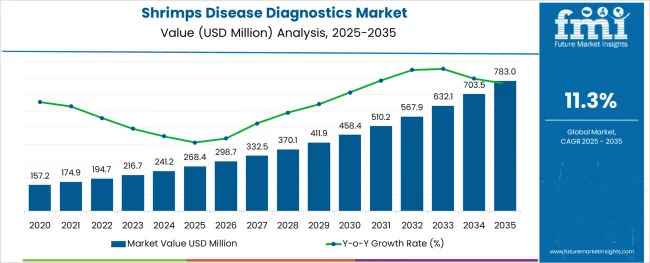
The shrimps disease diagnostics market is expanding due to increasing concerns over shrimp health and productivity in aquaculture. Industry insights indicate that disease outbreaks have significantly impacted shrimp farming yields, prompting the need for accurate and timely diagnostics. The adoption of advanced diagnostic techniques has enabled better disease management and prevention, helping farmers reduce losses and improve stock quality.
Growing global demand for shrimp as a protein source and increasing aquaculture activities in key producing regions have further driven the market. Regulatory emphasis on sustainable aquaculture practices and disease control has encouraged the deployment of effective diagnostic solutions.
Innovations in rapid testing and molecular diagnostics are improving detection speed and accuracy. The market is expected to continue growing as disease management becomes integral to shrimp farming success. Segmental growth is forecasted to be led by WSSV in disease type and fisheries in application due to their prevalence and economic importance.
The market is segmented by Type and Application and region. By Type, the market is divided into WSSV, TSV, YHV/GAV, IHHNV, HPV, MBV, IMNV, NHP-B, MoV, and Others. In terms of Application, the market is classified into Fisheries, Aquaculture Laboratories, Marine Laboratories, Education and Research Institutes, and Others.
Regionally, the market is classified into North America, Latin America, Western Europe, Eastern Europe, Balkan & Baltic Countries, Russia & Belarus, Central Asia, East Asia, South Asia & Pacific, and the Middle East & Africa.
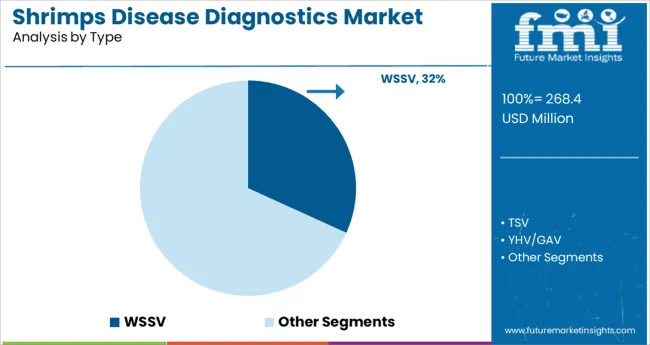
The WSSV (White Spot Syndrome Virus) segment is projected to hold 31.8% of the shrimps disease diagnostics market revenue in 2025, positioning it as the leading disease type. WSSV is a highly contagious viral infection causing significant mortality in shrimp populations worldwide. The segment growth is attributed to the high incidence rate of WSSV outbreaks in commercial shrimp farms and its severe impact on production volumes.
Diagnostic tests targeting WSSV have been prioritized for their role in early detection and effective containment of the virus. Rapid molecular and immunological diagnostic methods have improved farmers’ ability to monitor shrimp health and implement timely biosecurity measures.
The prevalence of WSSV in major shrimp-producing countries and its threat to export quality have reinforced the demand for accurate diagnostics within this segment.
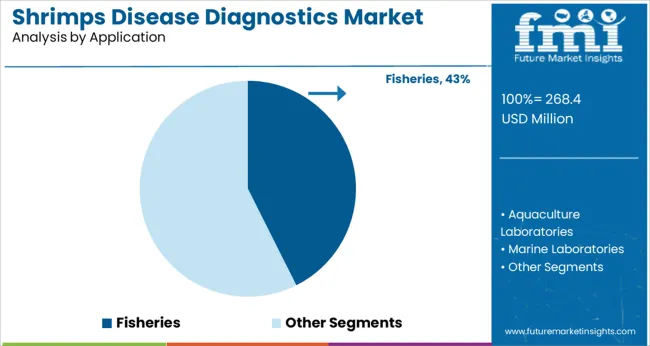
The Fisheries segment is expected to account for 42.6% of the shrimps disease diagnostics market revenue in 2025, maintaining its status as the leading application sector. This growth is driven by the extensive reliance on fisheries for shrimp production, where disease outbreaks pose a constant risk to productivity and economic viability.
Fisheries operations have increasingly integrated disease diagnostics into routine health management programs to prevent large-scale losses. The adoption of advanced testing kits and monitoring tools in fisheries has improved disease surveillance and stock management.
Environmental factors and intensive farming practices in fisheries have underscored the need for robust disease control mechanisms. Government initiatives promoting sustainable fisheries and disease control have also contributed to expanding diagnostic usage in this sector.
Growing demand for shrimps for human consumption and nutrient purpose is the major favour expected to boost up the sales of shrimp disease diagnostics system and the growth of shrimp disease diagnostics market. Rising demand for freshwater and marine shrimp farming is the major driving factor of the disease diagnostics market share.
Shrimp farming is gaining popularity for production of shrimp for human consumption. Thus, the demand for shrimp disease diagnostics system is also rising. Bacterial and viral infections are a major threat to the shrimp production industry in various countries. Shrimp production in many countries continues to face economic losses due to different diseases.
Disease problems in shrimp production are poorly understood and diagnosed. This factor propels the demand for shrimp disease diagnostics system to counter all the disease in shrimps. As a result, the sales of shrimp disease diagnostics system is also anticipated to grow during the forecast period.
Various shrimps diseases such as white spot diseases highly affect shrimp production and continue to pose a serious challenge, which is anticipated to affect the sales of shrimp disease diagnostics system.
There is no therapeutic option available for viral diseases, and the only option available is to detect and avoid the pathogen entry into culture systems. Therefore, the only option left is shrimps disease diagnostics.
This is also a major factor that is anticipated to augment the demand for shrimp disease diagnostics system and support the growth of disease diagnostics market share.
DNA based diagnostic tools such as PCR are used to test. Diagnosis tools and technologies are gaining demand for shrimp disease diagnostics system for quick and effective diagnosis of shrimp diseases to manage the disease outbreaks. Assay based kits and rapid test kits are available for the shrimp disease diagnostic market.
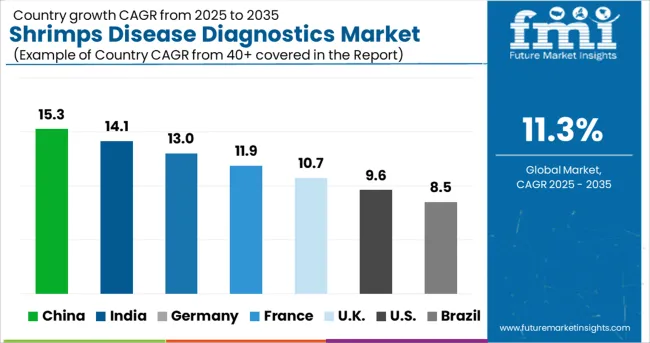
The Asia Pacific is expected to dominate the shrimp disease diagnostics market as high production rate in China and India. Sales of shrimp disease diagnostics system are increasing on the global level especially in Asia Pacific countries such as India and China. About 30% of farmed shrimp is produced in Asia, particularly in China and Indonesia.
Shrimps disease diagnostics market is expected to represent prominent growth in the countries such as the United States, Japan and Western Europe.
Growing consumption of shrimps in the food and strict regulatory policies regarding food safety in the countries such as the USA and Japan are expected to boost up the sales of shrimps disease diagnostics system and the growth of the shrimp disease diagnostics market.
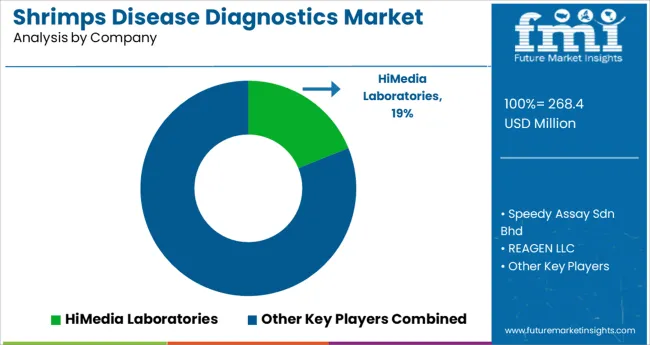
Key players in global shrimps disease diagnostics market are HiMedia Laboratories, Speedy Assay Sdn Bhd, REAGEN LLC, FUJIKURA KASEI CO., LTD., GeneReach Biotechnology Corp., Thermo Fisher Scientific, Lab - Ind Resource Sdn Bhd., AquaBounty Technologies, Inc., GeneReach Biotechnology Corp., pop bio, SUREBIO, Auro Biotechnologies and others.
Recent Developments
| Report Attribute | Details |
|---|---|
| Growth rate | CAGR of 11.3% from 2025 to 2035 |
| Base year for estimation | 2024 |
| Historical data | 2020 to 2024 |
| Forecast period | 2025 to 2035 |
| Quantitative units | Revenue in billion, volume in kilotons and CAGR from 2025 to 2035 |
| Report coverage | Revenue forecast, volume forecast, company ranking, competitive landscape, growth factors and trends, Pricing Analysis |
| Segments covered | Reagent Kits, Disease type, End user, region |
| Regional scope | North America; Western Europe; Eastern Europe; Middle East; Africa; ASEAN; South Asia; Rest of Asia; Australia and New Zealand |
| Country scope | USA, Canada, Mexico, Germany, UK, France, Italy, Spain, Russia, Belgium, Poland, Czech Republic, China, India, Japan, Australia, Brazil, Argentina, Colombia, Saudi Arabia, UAE, Iran, South Africa |
| Key companies profiled | HiMedia Laboratories; Speedy Assay Sdn Bhd; REAGEN LLC; FUJIKURA KASEI CO.; LTD.; GeneReach Biotechnology Corp.; Thermo Fisher Scientific; Lab - Ind Resource Sdn Bhd.; AquaBounty Technologies, Inc.; GeneReach Biotechnology Corp.; pop bio; SUREBIO; Auro Biotechnologies |
| Customization scope | Free report customization (equivalent to up to 8 analysts working days) with purchase. Addition or alteration to country, regional & segment scope. |
| Pricing and purchase options | Avail customized purchase options to meet your exact research needs. |
The global shrimps disease diagnostics market is estimated to be valued at USD 268.4 million in 2025.
It is projected to reach USD 783.0 million by 2035.
The market is expected to grow at a 11.3% CAGR between 2025 and 2035.
The key product types are wssv, tsv, yhv/gav, ihhnv, hpv, mbv, imnv, nhp-b, mov and others.
fisheries segment is expected to dominate with a 42.6% industry share in 2025.






Our Research Products

The "Full Research Suite" delivers actionable market intel, deep dives on markets or technologies, so clients act faster, cut risk, and unlock growth.

The Leaderboard benchmarks and ranks top vendors, classifying them as Established Leaders, Leading Challengers, or Disruptors & Challengers.

Locates where complements amplify value and substitutes erode it, forecasting net impact by horizon

We deliver granular, decision-grade intel: market sizing, 5-year forecasts, pricing, adoption, usage, revenue, and operational KPIs—plus competitor tracking, regulation, and value chains—across 60 countries broadly.

Spot the shifts before they hit your P&L. We track inflection points, adoption curves, pricing moves, and ecosystem plays to show where demand is heading, why it is changing, and what to do next across high-growth markets and disruptive tech

Real-time reads of user behavior. We track shifting priorities, perceptions of today’s and next-gen services, and provider experience, then pace how fast tech moves from trial to adoption, blending buyer, consumer, and channel inputs with social signals (#WhySwitch, #UX).

Partner with our analyst team to build a custom report designed around your business priorities. From analysing market trends to assessing competitors or crafting bespoke datasets, we tailor insights to your needs.
Supplier Intelligence
Discovery & Profiling
Capacity & Footprint
Performance & Risk
Compliance & Governance
Commercial Readiness
Who Supplies Whom
Scorecards & Shortlists
Playbooks & Docs
Category Intelligence
Definition & Scope
Demand & Use Cases
Cost Drivers
Market Structure
Supply Chain Map
Trade & Policy
Operating Norms
Deliverables
Buyer Intelligence
Account Basics
Spend & Scope
Procurement Model
Vendor Requirements
Terms & Policies
Entry Strategy
Pain Points & Triggers
Outputs
Pricing Analysis
Benchmarks
Trends
Should-Cost
Indexation
Landed Cost
Commercial Terms
Deliverables
Brand Analysis
Positioning & Value Prop
Share & Presence
Customer Evidence
Go-to-Market
Digital & Reputation
Compliance & Trust
KPIs & Gaps
Outputs
Full Research Suite comprises of:
Market outlook & trends analysis
Interviews & case studies
Strategic recommendations
Vendor profiles & capabilities analysis
5-year forecasts
8 regions and 60+ country-level data splits
Market segment data splits
12 months of continuous data updates
DELIVERED AS:
PDF EXCEL ONLINE
Disease Resistant Mask Market Analysis - By Type, Material, End-User, Distribution Channel, and Region - Trends, Growth & Forecast 2025 to 2035
Rare Disease Clinical Trials Market Size and Share Forecast Outlook 2025 to 2035
The lung disease therapeutics market is segmented by disease type, treatment type and distribution channel from 2025 to 2035
Rare Disease Gene Therapy Market
Swine Disease Diagnostic Kit Market Size and Share Forecast Outlook 2025 to 2035
Fabry Disease Market Size and Share Forecast Outlook 2025 to 2035
Byler Disease Market
Liver Disease Diagnostics Market Size and Share Forecast Outlook 2025 to 2035
Airway Disease Treatment Market Size and Share Forecast Outlook 2025 to 2035
Celiac Disease Diagnostics Market Analysis - Size, Share & Forecast 2025 to 2035
Chronic Disease Management Market Size and Share Forecast Outlook 2025 to 2035
The Addison Disease Testing Market Is Segmented by Test Type, and End User from 2025 To 2035
Pleural Diseases Therapeutics Market – Drug Trends & Future Outlook 2025 to 2035
Crohn’s Disease (CD) Treatment Market Analysis & Forecast by Drug Type, Distribution Channel and Region through 2035
Sandhoff Disease Therapeutics Market Size and Share Forecast Outlook 2025 to 2035
Zoonotic Disease Treatment Market Size and Share Forecast Outlook 2025 to 2035
Wilson’s Disease Diagnostics Market Analysis – Size, Share & Forecast 2023-2033
Predictive Disease Analytics Market Size and Share Forecast Outlook 2025 to 2035
Autoimmune Disease Therapeutics Market Analysis – Size, Share, & Forecast Outlook 2025 to 2035
Autoimmune Disease Testing Market Analysis - Size, Share, and Forecast Outlook 2025 to 2035

Thank you!
You will receive an email from our Business Development Manager. Please be sure to check your SPAM/JUNK folder too.
Chat With
MaRIA